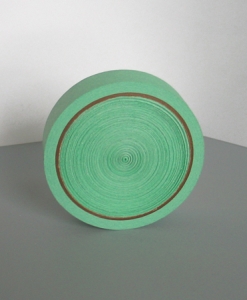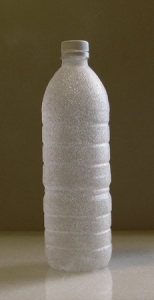
|
||
|
Portland art blog + news + exhibition reviews + galleries + contemporary northwest art
|
||
New Work From Brad Adkins
At PDX's Summer Group Show, Brad Adkins sets out to prove why he's just gained gallery representation by this Pearl District standby with a convincing new body of work. Adkins, who has done much of his most noted work in collaboration with Chris Buckingham as Charm Bracelet, moves away from social art interventions and instead offers the viewer a more intimate aesthetic experience. Among works in the main gallery space are a group of Adkins' altered plastic water bottles, a target-like form fashioned out of colored painters' tape and a stack of 25 one dollar bills, faces blacked with a Sharpie. I learned from Adkins that this group of work both signifies the closing of one project and the beginning of a foray into a new kind of art practice. The series of dollar bills began as a way for Adkins to make gifts for friends. Adorning each bill with a rectangle of solid black, Adkins obliterates all of the official markings that provide proof of value, but because of his viability as an artist, imbues them with greater market value. Adkins informed me that this was the last of these types of pieces he would create. This final large stack of bills is intended to be given away by its purchaser, which would of course put Adkins' currency back in the market, a sort of mini-experiment about value in the art market. The other works on display mark a focus on object making that uses common materials as its source. One of the first thoughts I had upon seeing these pieces was that Adkins must be a fan of Tom Friedman. As it turns out, not really. He doesn't have much interest in the sort of rarified experience of bringing an object into the studio the way Friedman does, nor does he hold the same interest in positioning the artist and the artists' process within each work. Adkins is more interested in the outcome of the completed work and in giving the viewer simple aesthetic gratification. The places where Adkins diverges from Friedman is most clear in his painters' tape, a roll of green masking tape whose interior has been completely filled with a roll of the same tape. Though Friedman's toilet paper piece comes to mind (a standard roll of toilet paper whose cardboard core has been removed and the paper re-rolled), Adkins treats his piece as an aesthetic object, using the cardboard support as a formal element and carefully re-rolling the interior shape imprecisely as to form gradations on the surface.
Adkins' plastic water bottles dominate as the most visually alluring peices in his new work. Although they retain their basic form, Adkins has drilled thousands of small holes in the surface, transforming them into essentially decorative objects. These pieces are intriguing not only because of their successful transformation into objects d'art, but by their inherent contradictions, the most obvious being that during this process, they have lost their functional value as vessels for holding liquid. A more fascinating phenomena is the way that the physical removal of material has resulted in rendering a clear object nearly opaque, allowing the light to play on its surface and lending the object a surprising amount of visual depth. Two similar bottles were auctioned off as part of PICA's birthday festivities and during the exhibition opening and celebration on Saturday, it was evident that others were as intrigued as I with these new pieces. After a strong showing at PDX that attests to a new direction and sharpness in his work, I am looking forward to seeing what Adkins might do with a larger body of work in a solo show. Posted by Katherine Bovee on June 13, 2005 at 9:25 | Comments (0) Comments Post a comment Thanks for signing in, . Now you can comment. (sign out)
(If you haven't left a comment here before, you may need to be approved by
the site owner before your comment will appear. Until then, it won't appear
on the entry. Thanks for waiting.)
|
| s p o n s o r s |
 |
 |
 |
 |
 |
 |
 |
 |
 |
 |
 |
 |
 |
 |

|
Site Design: Jennifer Armbrust | • | Site Development: Philippe Blanc & Katherine Bovee | |



